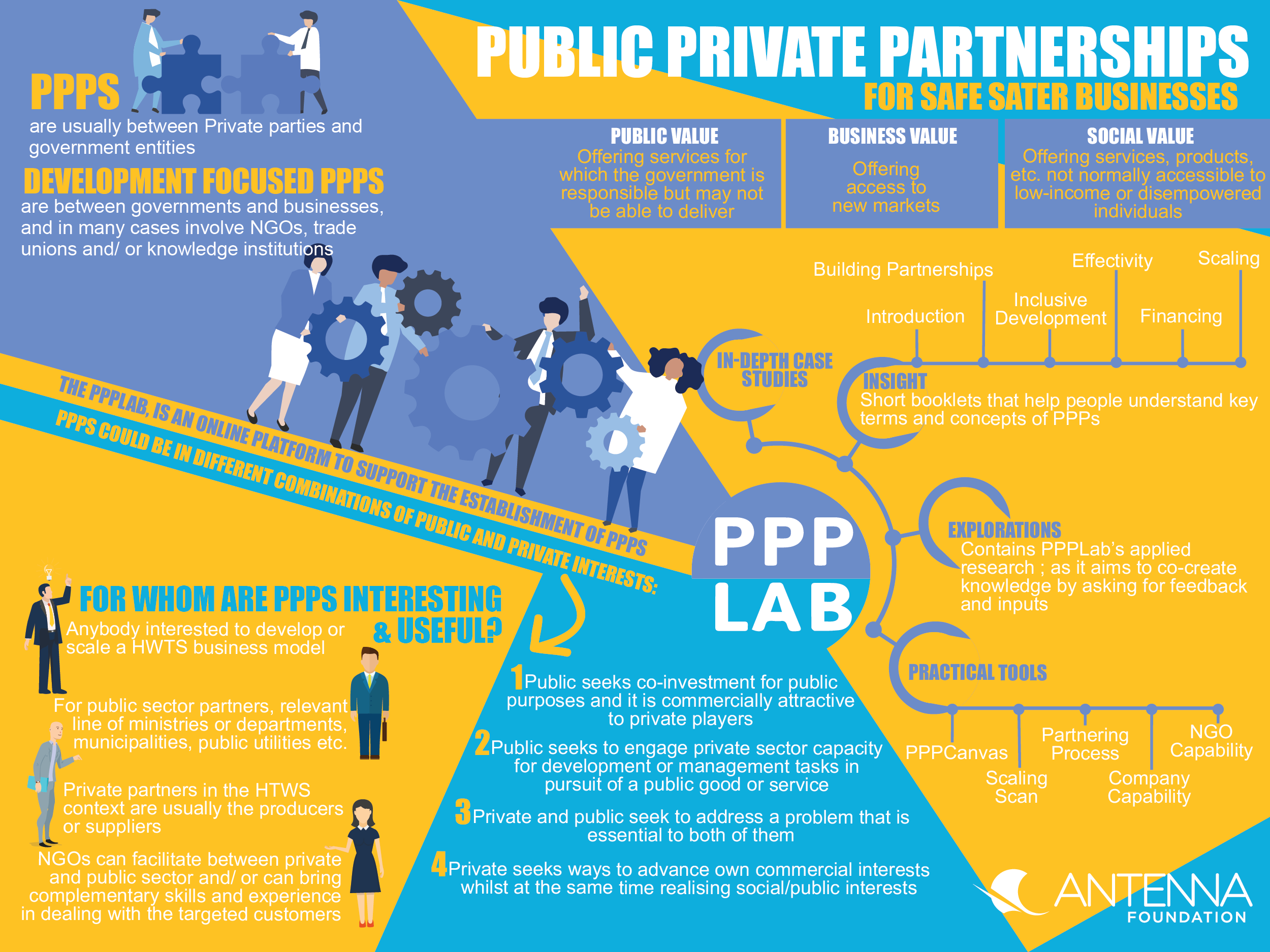Executive Summary

Public-Private Partnerships (PPPs) are a form of collaboration involving public and private entities with the aim providing a public asset or service.
This tool gives a brief introduction on why and how Public-Private Partnerships could be an important approach for safe water enterprises. It mainly draws from the work of the PPPLab (www.ppplab.org). The case study about a PPP in Ethiopia, where water utilities and filter suppliers collaborate to ensure households have access to safe water at point of use through household water treatment solutions (HWTS) provides practical insights and lessons learnt of developing a PPP.
What are PPPs about?
There are many definitions of what a PPP is. The World Bank uses the following “A long-term contract between a private party and a government entity, for providing a public asset or service, in which the private party bears significant risk and management responsibility and remuneration is linked to performance” (PPPKnowledgelab, 2018).
While this definition can be applied widely, it is mainly derived from PPPs for realising large infrastructure projects. In development focused PPPs, a broader take on PPPs could be formulated as “a form of cooperation between government and business (in many cases also involving NGOs, trade unions and/ or knowledge institutions) in which they agree to work together to reach a common goal or carry out a specific task, jointly assuming the risks and responsibilities, and sharing their resources and competencies” (MOFA, 2010). These PPPs can also be described as partnerships, as explained in the figure above.
PPPs may be used for different combinations of public and private interests:
- Public seeks co-investment for public purposes and the investment is commercially attractive to private players concerned. For example: infrastructure (e.g. water pipe) development that the government cannot afford to pay alone.
- Public seeks to engage private sector capacity for development or management tasks in pursuit of a public good or service. For example: management of a public hospital, airport or water provision.
- Private and public seek to address a problem that is essential to both of them. For example: the development of a technical innovation in which private and public parties co-invest.
- Private seeks ways to advance own commercial interests whilst at the same time realising social/public interests and strengthening its ‘license to operate’. For example: inclusive business in an agricultural value chain/commodity.
Some PPPs clearly sit within one specific category. Others may combine different logics in this respect.
PPPs have gained interests both from a private and public-sector perspective: companies and investors are increasingly looking at balancing profit goals with social and environmental targets: Profit plus Impact; To address challenges with sustainability and scale, public funding is increasingly looking for synergies with private sector goals and expertise: Impact plus Profit (PPPIRC, 2015; PPPLAB, 2018).
Why are PPPs relevant for safe water enterprises?
HWTS products could be promoted and scaled through could Public-Private Partnerships (PPPs), as HWTS models can create a combination of:
- Public value: offering services for which the government is responsible but may not be able to deliver;
- Business value: offering access to new markets;
- Social value: offering services, products, etc. not normally accessible to low-income or disempowered individuals.
Often, this needs a mix of skills and resources that no single party can offer and usually takes considerable time to develop into a real business proposition. Unconventional partnerships between for-profit companies, public authorities and NGOs, known as a public-private partnerships (PPPs) are a way to deal with these challenges and sharing the risks.
For (social) enterprises working in the drinking water sector it is almost unavoidable working with governments as water is a public good and access to drinking water a basic human right. However, having to deal with issues like water quality standards, government policies etc. doesn’t yet mean you have a real and strong PPP. Within a PPP you make clear and binding arrangements with the partners within the PPP. While developing PPPs to scale HWTS will require time and efforts, it may ultimately be a better option to reach more people more sustainably than through individual HWTS producers/ suppliers. With both the government and the private sector aligned within a PPP, larger audiences can be reached. Also can policies and other obstacles in the enabling environment be tackled easier and both parties can contribute financial and human resources, skills, networks etc. (PPPLAB, 2018)
Subscribe here to the new Sanitation and Water Entrepreneurship Pact (SWEP) newsletter. SWEP is a network of organizations joining hands to help entrepreneurs design and develop lasting water and sanitation businesses.
For whom are PPPs interesting and useful?
PPPs could be useful for anybody interested to develop or scale a HWTS business model. This concretely includes the potential partners within a PPP, as well as development partners and (impact) investors that would like to financially support scaling of HWTS.
PPP partners in general mean the public and private parties that will enter into an agreement. More specifically, for public sector partners one could think of relevant line ministries or departments, municipalities, public utilities etc.
Private partners in the HTWS context are usually the HWTS producers and/ or suppliers. In development-focused PPPs, NGOs are also often included as a partners, as they can be a good facilitator between the private and public sector and/ or can bring complementary skills and experience in dealing with the targeted customers.
How can the PPPs be implemented?
This factsheet will guide the reader to gain more insights on PPPs, so a PPP approach could be more consciously considered and more effectively and efficiently developed. To implement PPPs different strategies can be pursued. In order to facilitate this development a project of the Dutch Government and executed by Aqua for All developed the PPPlab, an online platform to support the establishment of PPPs.
The PPPlab developed a series of tools and research papers that are easy to use and user guidelines/ explanation is provided where necessary, however, it is up to the user to decide whether that is sufficient or whether a moderator/ facilitator would be preferred to apply the tools. E.g. when using the Partnering Process Tool individual perceptions about how the partnership is functioning will come to the fore that people may feel awkward or difficult to discuss.
The materials and tools are all freely downloadable from the website and are introduced subsequently.
The PPPlab produced a collection of Insight Series, short booklets that help people (wanting to be) involved in PPPs understand key terms and concepts. These booklets summarise existing knowledge and/ or make existing knowledge more easily accessible from a PPP point of view. So far Insight Booklets have been published about the following topics:
- Insight Series 01: Public-Private Partnerships, a brief introduction
- Insight Series 02: Building Partnerships
- Insight Series 03: Partnerships for Inclusive Business Development
- Insight Series 04: Financing Public-Private Partnerships
- Insight Series 05: How can PPPs work effectively with the Public P?
- Insight Series 06: Scaling through PPPs
There is also an Explorations Series that contains PPPLab’s own applied research work; as the PPPLab aims at co-creation of knowledge and would like to stimulate debate, it may put ongoing work online through this series, explicitly asking for feedback and inputs.
In the Explorations Series so far the following documents have been published:
- Explorations 01: A portfolio scan of the Sustainable Water Fund (FDW)
- Explorations 02: Business Models in Food and Water PPPs
- Explorations 03: A portfolio scan of the Facility for Sustainable Entrepreneurship and Food Security (FDOV)
- Explorations 04: Scaling: From simple models to rich strategies
- Explorations 05: Working with the Public P
The PPPLab also published two in-depth case studies:
- Understanding the Public P: Insights from an FDOV PPP in Kenya
- Understanding the Public P: Insights from a PPP case of water management in North Ghana
PPPLab has developed several practical tools that are available online:
- PPPCanvas – a tool that helps to develop the business model for a PPP;
- Scaling Scan – a tool to help you to analyse, reflect on and sharpen your scaling ambition and approach;
- Partnering Process Tool - helps partners within a PPP to quickly assess how the partnering process is working;
- Company Capability Scan - a tool for businesses to check their internal capacities to start or strengthen inclusive business in developing countries;
- NGO Capability Scan - a tool for NGOs to check their internal capacities to start or strengthen inclusive business in developing countries;
Additional PPPLab tools assisting in developing a financing strategy and working effectively with government are expected to be made online in the future.
The case study on water utilities selling HWTS in Ethiopia shows the establishment of a PPP very practically.
Public-Private Partnerships in developing countries
About the Knowledge Lab
What are Public Private Partnerships?
The APMG Public-Private Partnerships Certification Program
Guidebook on promoting Good Governance in Public-Private Partnerships
Tool Kit for Public-Private Partnerships in Urban Water Supply for the State of Maharashtra, India
A variety of tools for the evaluation of PPPs in the water sector applied in the Indian context. Easily adaptable for the other contexts.
ANOUJ, M. (2011): Tool Kit for Public-Private Partnerships in Urban Water Supply for the State of Maharashtra, India. Mandaluyong City: Asian Development Bank URL [Accessed: 19.06.2018]Private Sector Provision of Water Supply and Sanitation Services in Rural Areas and Small Towns : The Role of the Public Sector
This paper provides insights on domestic private sector participation (DPSP) as an effective and proven approach to address challenges in small towns’ water and sanitation services delivery. The report aims at helping national and local governments in developing countries and water professionals to better engage with the domestic private sector in the provision of sustainable water and sanitation services in rural growth areas and small towns.
NDAW, M. (2016): Private Sector Provision of Water Supply and Sanitation Services in Rural Areas and Small Towns : The Role of the Public Sector. Washington, DC: World Bank URL [Accessed: 19.06.2018] PDFDelivering Universal and Sustainable Water Services: Partnering with the Private Sector
This study provides an assessment of the global costs of meeting the WASH-related targets of Goal #6. The targets assessed include achieving universal and equitable access to safe and affordable drinking water for all (target 6.1), achieving access to adequate and equitable sanitation and hygiene for all, and ending open defecation (target 6.2).
MENZIES, I. (2016): Delivering Universal and Sustainable Water Services: Partnering with the Private Sector. URL [Accessed: 19.06.2018] PDFAqua for All NGO
Aqua for All is a non-profit organization established in 2002 by the Dutch water sector. Aqua for All is a well-known source of expertise on water, sanitation and hygiene-related challenges, offering a broad range of services to the public and private sector. With its business-like, efficient and result-oriented approach, the organization inspires and supports its stakeholders to help the world’s Base of the Pyramid gain sustainable access to safe water and adequate sanitation.
PPPLab
The PPPLab is an action research and joint learning and support initiative to learn about the relevance and effectiveness of PPPs. Starting point is the Dutch government supported public-private partnerships (PPPs) in the food and water domains in developing countries. Its mission is to extract and co-create knowledge and methodological lessons from and on PPPs that can be used to improve both implementation and policy.


